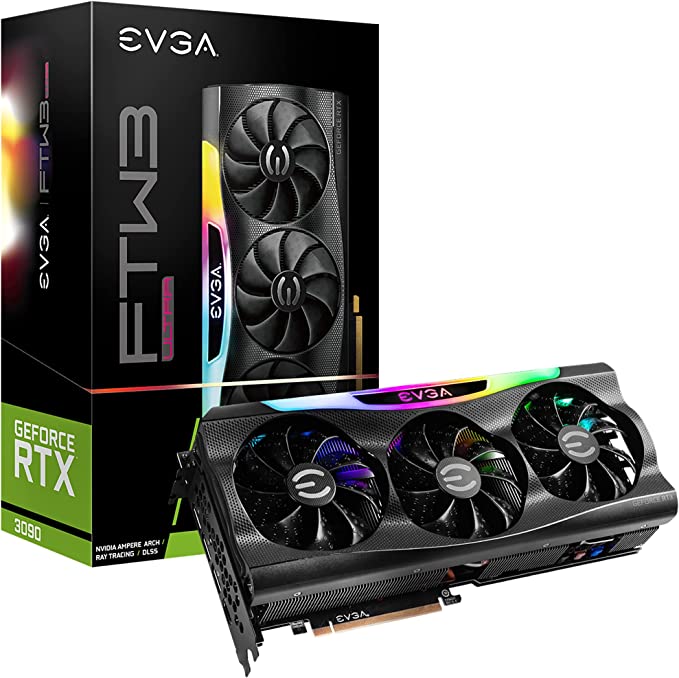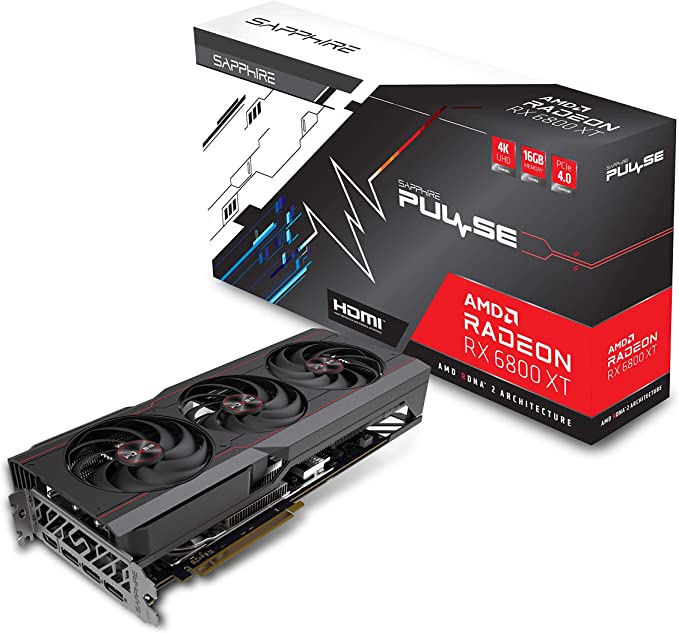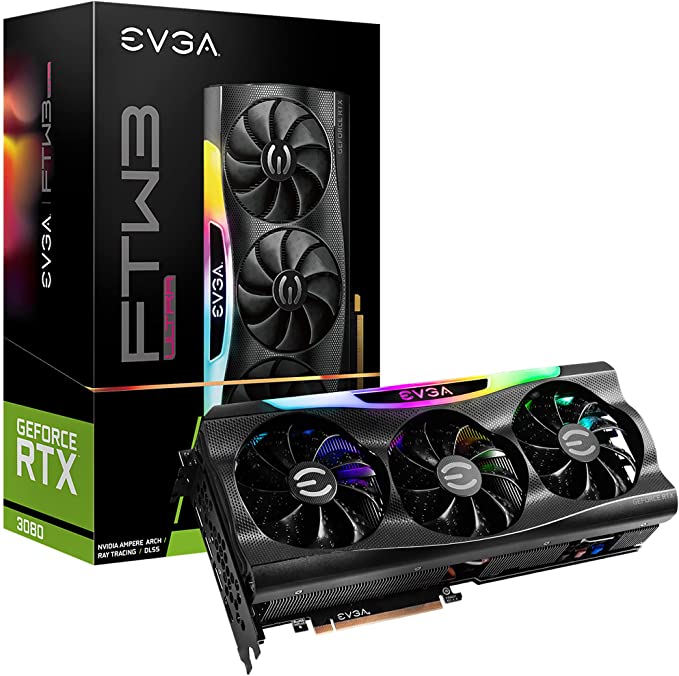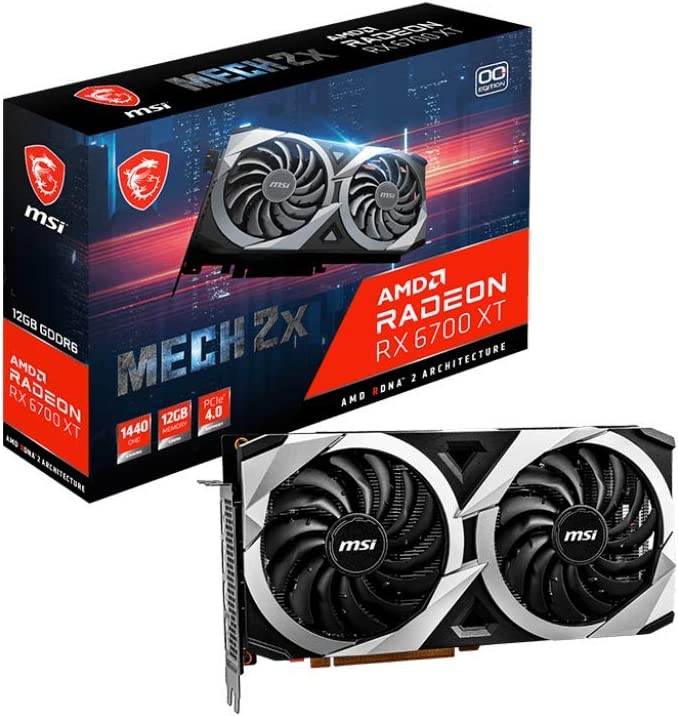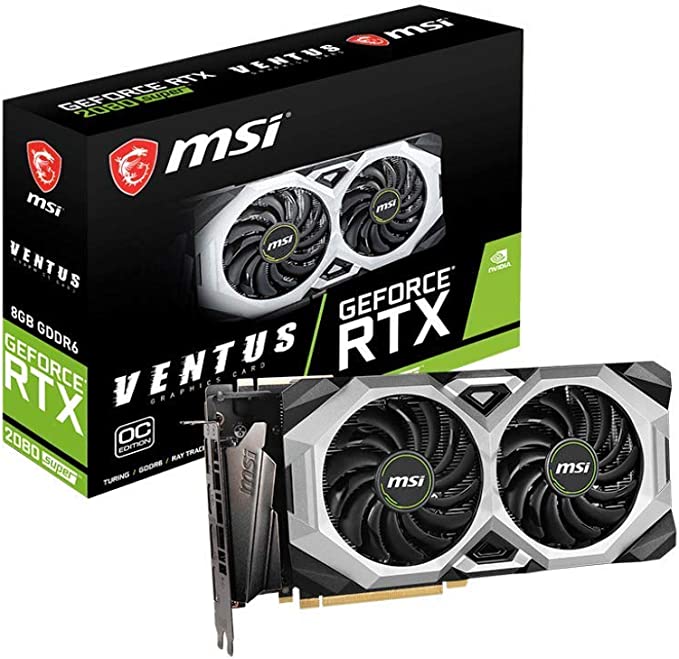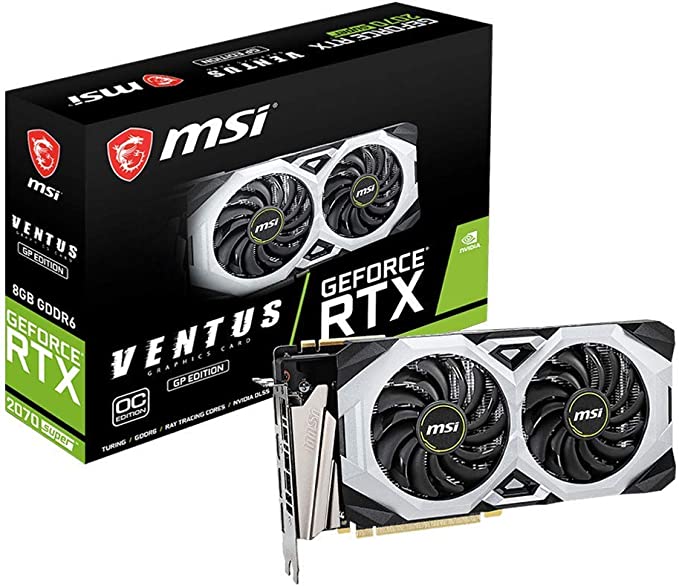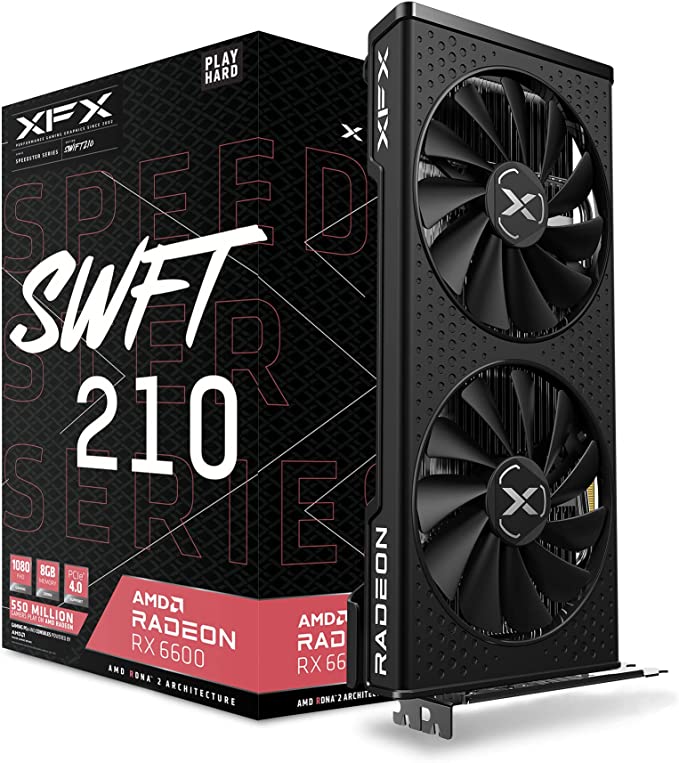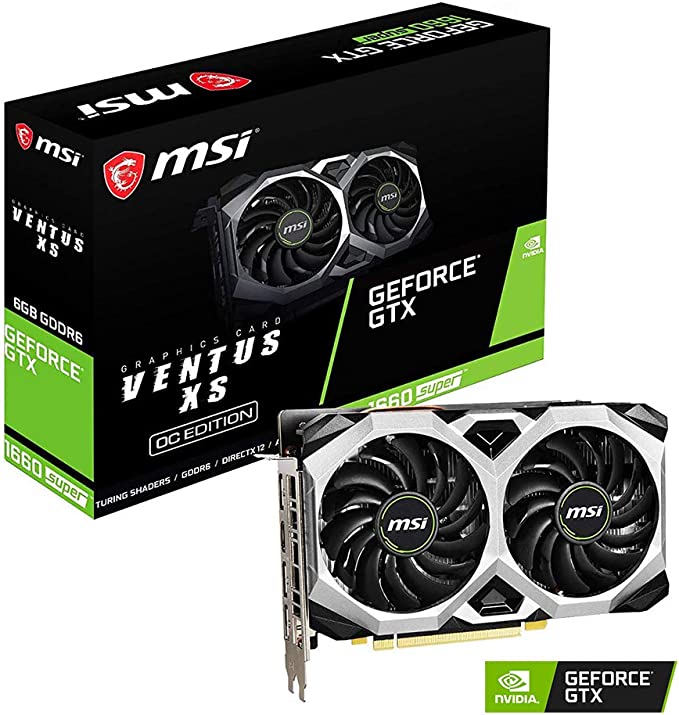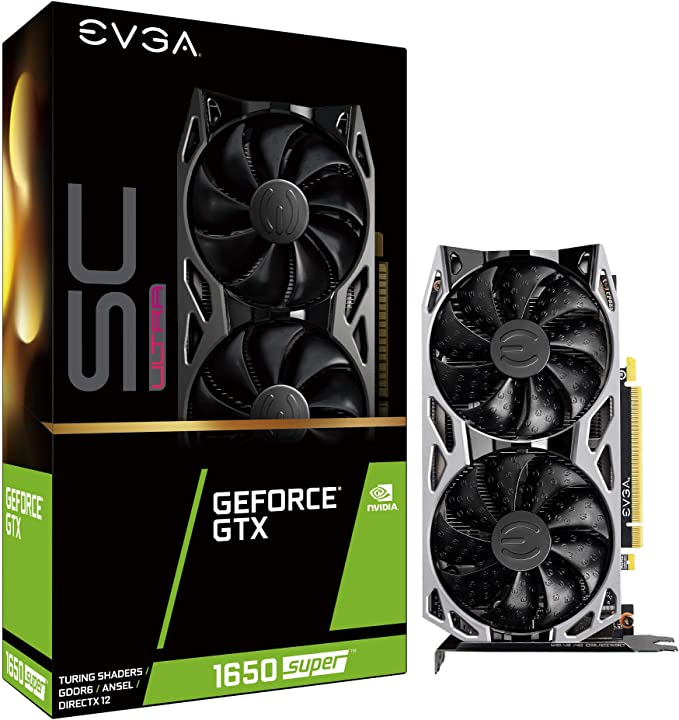If you’re making a build specifically for streaming, then you’re going to want the perfect GPU. The GPU is arguably the most important piece of hardware when it comes to streaming, and many GPUs even have built in encoders to help you out.
There are so many GPUs on the market to choose from, though, so which should you get?
1. GeForce RTX 3090
SPECIFICATIONS
| Name | GeForce RTX 3090 |
| Memory | 24 GB |
| Memory Type | GDDR6X |
| Fans | 3 |
| Interface | PCIe 4.0 x16 |
| Display Ports | 1x HDMI 2.1, 3x DisplayPort 1.4a |
| Dimensions | 15.1″ x 12″ x 5″ (L x W x H) |
WHERE TO BUY
View On AmazonPROS
- Unmatched gaming performance
- Easy 4k gaming and streaming
- Quiet and cool
CONS
- Power supply unit of at least 750W required
- Expensive
If you can afford it and if your setup can handle it, you’re not going to find any card better than the RTX 3090. Whether you’re streaming or not, this card will be an absolute monster. It’s truly state of the art.
This is the best card for streaming because you’ll be able to stream in 4k while keeping your frames above 60, and even 100 for most games.
The only real downsides to this card come from its power usage. NVIDIA recommends a 750W PSU (power supply unit) for running this card. In all reality, you may even have to go a little higher than that just to be safe. However, despite its power draw and its performance, this card is actually rather quiet and cool which is very surprising.
If I could choose any card and had an unlimited budget, I’d choose the RTX 3090 every time. NVIDIA cards are always fantastic for streaming, and the 3090 is no different.
2. Radeon RX 6800 XT
SPECIFICATIONS
| Name | AMD Radeon RX 6800 XT |
| Memory | 16 GB |
| Memory Type | GDDR6 |
| Fans | 3 |
| Interface | PCIe 4.0 x16 |
| Display Ports | 1x HDMI 2.1, 2x DisplayPort 1.4a, 1x USB Type-C |
| Dimensions | 17″ x 9.5″ x 3.5″ (L x W x H) |
WHERE TO BUY
View On AmazonPROS
- 1440p and 4k gaming capabilities
- 16 GB of VRAM
- Cheaper than NVIDIA counterparts
CONS
- Huge power draw
- Hot and loud under load
- No DLSS
With AMD GPUs you’re probably going to want your CPU to do your stream encoding most of the time. I’ve heard that YouTube handles streaming differently than Twitch, and that AMD cards are great at streaming to YouTube compared to Twitch, so keep this in mind if you really want to use your GPU for encoding.
This card is extremely strong, there’s no question about it. It has 16 GB of VRAM, and is just extremely powerful. It can handle 4k gaming, no problem.
The issues will come with streaming, which is what this article is about and why this couldn’t be number 1. If you have a great CPU to pair this with that will handle the encoding, then this card is great. Otherwise, you should really consider a NVIDIA card, which will come with DLSS and built-in encoding for fantastic stream quality.
3. GeForce RTX 3080
SPECIFICATIONS
| Name | GeForce RTX 3080 |
| Memory | 10 GB |
| Memory Type | GDDR6X |
| Fans | 2 |
| Interface | PCIe 4.0 x16 |
| Display Ports | 1x HDMI 2.1, 3x DisplayPort 1.4a |
| Dimensions | 14.9″ x 9.3″ x 4.3″ (L x W x H) |
WHERE TO BUY
View On AmazonPROS
- Improved ray tracing and DLSS technology
- PCIe 4.0 and 10 GB of VRAM
- Reflex, Broadcast, G-SYNC 360, and RTX-IO features
- Can handle 4k gaming and streaming
CONS
- Can get loud under stress
- Draws a lot of power
The RTX 3080 is a beast of a GPU, which is a good and a bad thing at the same time. It’s good because you should be able to stream most games in 4k, with a decent framerate (60+ FPS).
So if streaming is your goal, a 3080 is one of the best options you can grab. Other GPUs may be able to hit the same benchmark, but they probably won’t be anywhere near as consistent when streaming in 4k. Being an RTX GPU, it also has great DLSS and ray tracing features, which will make your games look that much better.
The major downsides for this card come from its power usage. It has a 12-pin power adapter, so your machine has to be able to handle that. It also draws a lot of power, meaning your PSU (power supply unit) has to be prepared for it. You’ll probably want a 750W PSU or better.
4. Radeon RX 6700 XT
SPECIFICATIONS
| Name | Radeon RX 6700 XT |
| Memory | 12 GB |
| Memory Type | GDDR6 |
| Fans | 2 |
| Interface | PCIe 4.0 x16 |
| Display Ports | 1x HDMI 2.1, 3x DisplayPort 1.4a |
| Dimensions | 9.7″ x 2″ x 5.2″ (L x W x H) |
WHERE TO BUY
View On AmazonPROS
- Perfect performance at 1440p
- 12 GB of VRAM
CONS
- No DLSS
- Requires 650W PSU
- High temps and noisy under stress
- Poor Encoder
The streaming for this card is passable. It is an extremely powerful card, don’t get me wrong, but the encoder just doesn’t keep up with NVIDIA NVENC encoders. However, keep in mind that your CPU can do the encoding, which makes this a very viable card just due to how powerful it is.
This card will be able to run any game you throw at it, and if you have a strong CPU that can handle the actual encoding, then you’ll have fantastic results.
Other than pure stream quality, you should know that you’ll need a 650W power supply unit in your build for this GPU. This has become common place with newer GPUs, so if you haven’t upgraded your PSU yet, then you should start thinking about doing so.
Overall, I’d probably choose an NVIDIA card for streaming, but if you have a nice CPU already, the Radeon RX 6700 will work fine.
5. GeForce RTX 2080
SPECIFICATIONS
| Name | GeForce RTX 2080 Super |
| Memory | 8 GB |
| Memory Type | GDDR6 |
| Fans | 2 |
| Interface | PCIe 3.0 x16 |
| Display Ports | 1x HDMI 2.0, 3x DisplayPort 1.4a, 1x USB Type-C |
| Dimensions | 10.1″ x 2″ x 5″ (L x W x H) |
WHERE TO BUY
View On AmazonPROS
- Has new features like DLSS and ray tracing
- Extremely powerful GPU
- Turing architecture greatly improves stream quality
- Great for 1440p streaming
CONS
- Draws more power than normal GPUs
- Can’t keep framerate at 60+ FPS while streaming in 4k
The RTX cards in general are great for streaming, and the 2080 is the start of the true beasts. With the RTX 2080, you’ll be able to play and stream pretty much anything you want at very high resolutions.
The DLSS technology makes high resolutions much easier to render and stream. DLSS involves using ai and deep learning to improve graphics quality at high resolutions, without using nearly as much processing power as past GPUs would’ve had to use.
Most modern and semi-modern NVIDIA GPUs come with a built-in encoder, but in the past these encoders had to sacrifice quality for performance. With the RTX 2080, this trade off isn’t nearly as bad, thanks to the Turing architecture.
Overall, this GPU will be fantastic for streaming, especially at 1440p. You should have a smooth framerate and your stream should look great, no matter what game you’re playing.
6. GeForce RTX 2070 Super
SPECIFICATIONS
| Name | GeForce RTX 2070 Super |
| Memory | 8 GB |
| Memory Type | GDDR6 |
| Fans | 2 |
| Interface | PCIe 3.0 x16 |
| Display Ports | 1x HDMI 2.0, 3x DisplayPort 1.4a, 1x USB Type-C |
| Dimensions | 10.2″ x 1.7″ x 5″ (L x W x H) |
WHERE TO BUY
View On AmazonPROS
- Keeps up with RTX 2080 in many regards
- Very powerful card, in general
- NVENC (encoder) built-in for streaming
- Can stream in 4k
CONS
- Large size
- Consumes a lot of power
- Not strong enough for 4k at max settings for all games
Alright, this is the first real monster at the list and probably the best card for streaming without going overkill. This can stream Apex Legends on 4k resolution with an average FPS of about 80.
This means games like League of Legends, Fortnite, and Valorant are going to have absolutely no problem streaming in 4k. Now, if you want more FPS, you’ll have to upgrade a little bit, but for 90% of streamers, this will do.
If you play games with more intense graphics than Apex, modern AAA games for example, you may also want to upgrade if you want your stream to be 4k at max settings. However, if you’re just going to stream some competitive games and don’t want to spend a grand on a new card, this is the GPU for you.
7. Radeon RX 6600
SPECIFICATIONS
| Name | Radeon RX 6600 |
| Memory | 8 GB |
| Memory Type | GDDR6 |
| Fans | 2 |
| Interface | PCIe 4.0 x8 |
| Display Ports | 1x HDMI 2.1, 3x DisplayPort 1.4a |
| Dimensions | 9.49″ x 5.16″ x 1.61″ (L x W x H) |
WHERE TO BUY
View On AmazonPROS
- Encoder on par with NVIDIA’s NVENC
- Great for 1080p streaming
- 8 GB VRAM
- Powerful card, overall
CONS
- Struggles with 1440p streaming
- Not nearly as good as newer GPUs
This card is pretty good, all things considered. It’ll be able to run pretty much any game you want. Even though it’s not an NVIDIA card, it still has a built-in encoder that I have heard many good things about.
Some people say it’s on par with NVENC, while others claim it just doesn’t cut it. However, as long as you limit your FPS in game while you stream (so that your GPU can dedicate resources to streaming), this card should get the job done.
On low settings for a game like Apex Legends, you should hit over 100 FPS while streaming with this card. This means for games like League of Legends or Valorant, you should be able to hit these numbers on high settings, no problem.
So, no matter which game you play, this card will be passable and a great option if you don’t want a NVIDIA card for some reason.
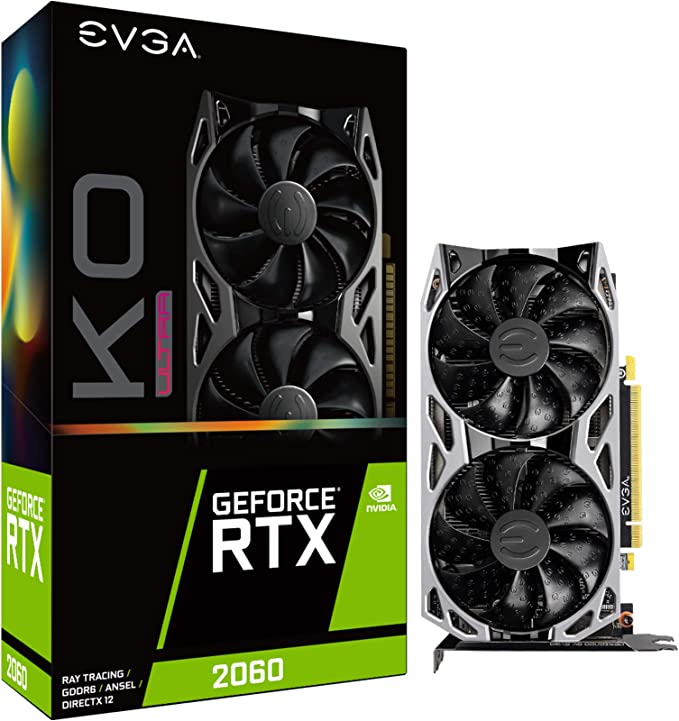
8. GeForce RTX 2060
SPECIFICATIONS
| Name | GeForce RTX 2060 |
| Memory | 6 GB |
| Memory Type | GDDR6 |
| Fans | 2 |
| Interface | PCIe 3.0 x16 |
| Display Ports | 1x DVI, 1x HDMI 2.0, 2x DisplayPort 1.4a, 1x USB Type-C |
| Dimensions | 7.96″ x 1.54″ x 4.38″ (L x W x H) |
WHERE TO BUY
View On AmazonPROS
- Runs cool
- Can stream 1080p at 60 FPS consistently
- NVENC encoder for streaming
- 6 GB of VRAM
CONS
- No LED
- Some games may take configuration to stream well
- Not worth the upgrade from a 1660 Ti or better
This card has the same old story as the others. It’s great for streaming some games while it may struggle with others. However, with some configuration, you should be able to stream anything you want at pretty good settings.
However, the stream quality won’t be a result of this card’s build, but of OBS’s optimization, so thank the engineers over there!
The card is great, it has 6 GB of VRAM, it’s fast, it has an encoder for streaming, so you’ll be able to run just about anything. Streaming on the other hand may be a bit harder. For reference, you’ll be able to stream a game like League of Legends without any issues and get almost infinite frames.
However, if you want to stream a game like Apex Legends, then you may need to play with some settings before your stream comes through as smooth as the game does on your end. For example, you’ll need to cap your frames in game and maybe mess with your bit rate in your streaming software.
I’d say this is a solid mid-range graphics card that’ll get the job done for most hobbyist streamers. With an infinite budget, I’d get something stronger. But realistically, this is the card I’d choose.
It may take a bit of Googling, depending on the game you play, but you should be able to stream anything you want with a solid framerate.
9. GeForce GTX 1660 Super
SPECIFICATIONS
| Name | GeForce GTX 1660 Super |
| Memory | 6 GB |
| Memory Type | GDDR6 |
| Fans | 2 |
| Interface | PCIe 3.0 x16 |
| Display Ports | 1x DVI, 1x HDMI 2.0, 1x DisplayPort 1.4a |
| Dimensions | 8″ x 1.7″ x 5″ (L x W x H) |
WHERE TO BUY
View On AmazonPROS
- Great performance at 1080p (without streaming)
- Powerful card
- Great value
CONS
- Limited Display Ports
- Some games may have to stream at 720p
- Limted frames at 1440p and even less at 4k
- May struggle streaming more graphic-intensive games
Here’s another Super card, and it’s a little bit of an upgrade form the 1650. Similar to the 1650, this is the card that’ll let you stream games like Valorant, League, etc with fantastic quality. However, if you want to stream AAA games at 1080p 144+ FPS, it’s just not going to happen.
You may be able to hit 60 FPS on those games while streaming, though, which makes this card a much better choice than the 1650 Super.
Just like the 1650 GPU, this has an encoder which will make streaming so much easier on the card. If you’re playing Valorant, League, Fortnite, or even Apex Legends, you can almost certainly hit the 60 FPS we all crave.
The encoder should even allow you to hit well over 60 FPS while streaming for these games. Games that are harder to run though, like AAA story games, will have a different story.
Overall, it’s a good card but it’s not the best. If you’re on a budget, then this is only a little more costly than the 1650 but will show much better performance. You’ll pretty much be able to stream anything you want. Don’t expect to get infinite frames with your settings on high, but you may be able to squeeze out 60 from most of them.
If you’re not on a budget, spring for a 2060 or better, which will have more features built specifically for streaming.
10. GeForce GTX 1650 Super
SPECIFICATIONS
| Name | GeForce GTX 1650 Super |
| Memory | 4 GB |
| Memory Type | GDDR6 |
| Fans | 2 |
| Interface | PCIe 3.0 x16 |
| Display Ports | 1x DVI, 1x HDMI 2.0, 1x DisplayPort 1.4a |
| Dimensions | 7.96″ x 1.54″ x 4.38″ (L x W x H) |
WHERE TO BUY
View On AmazonPROS
- Best GPU for its price
- Quiet and cool
- Dedicated hardware encoder makes streaming much easier
CONS
- Not as powerful as newer GPUs
- May not reach a consistent 144+ FPS on many games
- Not great for modern AAA games
This card is up here because it’ll be the perfect card for many streamers, while being a terrible choice for others. It all depends which games you play, your budget, and what quality you’re aiming for.
If you’re playing games like Fortnite, League, and even Valorant, then this card may be the perfect, cheapest choice for you. If you want to stream games like Apex Legends or Tarkov on high settings, then you’ll have to spend a bit more money.
Overall, this card is great. It has a built-in encoder that will work with OBS to make streaming much easier. A built-in encoder just means there’s a little chip on the card that will do the streaming processing, which will take the effort off of your actual card so it can focus on just rendering the game. This will make your game and your stream look and run better.
If you’re on a tight budget and not looking to stream very hard-to-run games, then this is the card for you. If you’re not on a budget, or want to be able to stream any game you pick up, then you’re going to want to grab something a bit newer.
Most NVIDIA cards nowadays have the built-in encoder that makes streaming a breeze, so you’ll see a lot on this list.
What To Look For In A Streaming GPU?
In a streaming GPU, you will want to look for high VRAM and a quality built-in encoding (ie NVENC). This will take a lot of strain off of your GPU when you stream and make it much easier. Beyond the built-in encoder, DLSS is a great feature that will allow the card to run games at very high resolutions.
All modern NVIDIA cards have a built-in encoder, which makes streaming extremely easy. The built-in encoder will pretty much handle the streaming side of things, while your actual card can focus completely on rendering your game. Other than that, the VRAM is always important in GPUs, whether streaming or not, and will play a big role in what kind of frames you get.
DLSS is a semi-new feature of cards that uses ai deep learning to improve game graphics without actually computing them. I’m not smart enough to explain the math and science, but this feature allows you to run games at higher resolutions while still getting beautiful graphics without significantly impacting your performance.
Streaming is getting easier and easier for GPUs thanks to new features like DLSS and encoders, and most modern cards are picking up features like this. Other than these features, you’ll just want to choose a card that can handle the games you play. Make sure it has plenty of VRAM (6 GB+ preferably) and decent bandwidth so the game doesn’t stutter on your machine and you’ll be fine.
Do You Need A GPU For Streaming?
You do not need a GPU for streaming, as streaming is more CPU intensive most of the time. There is a limit to what your CPU can stream, however, so eventually a GPU will be necessary. Streaming games with better graphics that are harder to run will be impossible without a dedicated GPU of some kind.
Technically you do not need a GPU for streaming, but it will depend heavily on what game you stream. I’ve streamed indie style pixel art games from an old college laptop with a low-end CPU and integrated graphics. My stream didn’t look perfect, and I wouldn’t dream of playing a game like League of Legends or Valorant, but it was possible.
Most streaming software will have settings that allow you to choose between using your GPU and CPU, so it’s possible to get away with a low-end GPU as long as your CPU can handle running the game and streaming.
How Does GPU Affect Streaming?
Modern GPUs come with built-in encoding which makes streaming much easier for them. The built-in encoder allows a GPU to stream gameplay without affecting actual gameplay. Most new NVIDIA GPUs also come with DLSS, which uses deep learning to improve graphics quality at high resolution without affecting FPS.
Most likely your streaming software will let you choose between using your CPU and GPU. Simply put, if you have a NVIDIA card, you’ll be able to use its built-in encoder to stream. While if you have an AMD card, you’ll probably want to use your CPU to stream because the AMD encoder just isn’t as good.
Whether you use your GPU or CPU for encoding, your GPU will determine how good your graphics are while you play, and how good they look on stream.
Is OBS CPU Or GPU Intensive?
OBS is a CPU intensive program. Streaming requires a strong CPU because it has to process and encode your gameplay so it can be streamed. There are settings in OBS that will allow you to use NVENC if you have an NVIDIA GPU. This will make streaming more GPU intensive than CPU intensive compared to x264.
OBS will use whichever device you tell it to use. AMD and NVIDIA GPUs both have built-in encoders which you can have OBS use.
However, the CPU encoder (x264) will look and stream much better. So, if you do have a monster CPU, it’s better to use that no matter what. On top of this, AMD encoders aren’t as good as NVIDIA encoders, so if you have an AMD graphics card, you should use CPU encoding in OBS.
AMD vs NVIDIA: Which Is Better For Streaming?
NVIDIA is better for streaming thanks to its NVENC encoding. This encoder works very well with the most popular streaming platforms(Twitch) and programs (OBS). New NVIDIA cards also come with DLSS technology, which uses deep learning to improve graphics, making it much easier to stream in high resolution.
The consensus among most streamers and gamers is that NVIDIA cards are much better for streaming because NVENC is so strong. If you have a very strong CPU, you can actually set OBS up to use your CPU for encoding. In this case, an AMD card would actually work very well. CPU encoded streaming is actually higher quality, but most people still use NVIDIA’s NVENC when streaming because it is more accessible to the average streamer.
For even more streaming tips and how-to content check out my Youtube channel here. And if you want to check out my streams then stop by my Twitch channel here.
Eric streams 3 days a week on Twitch and uploads weekly to Youtube under the moniker, StreamersPlaybook. He loves gaming, PCs, and anything else related to tech. He’s the founder of the website StreamersPlaybook and loves helping people answer their streaming, gaming, and PC questions.

